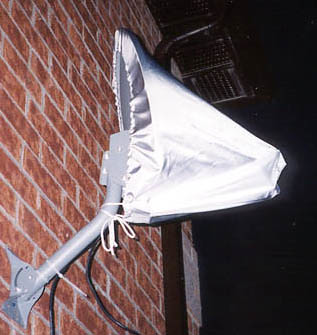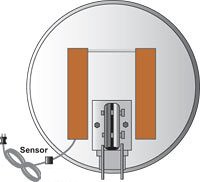DIY Friday: Removing Snow from Your Satellite Dish
Spray it. Spraying some Pam cooking spray on your dish at the start of winter is usually the traditional way of avoiding signal-destroying, satellite dish snow build-up. While this tends to work OK, if you’re dish is inconveniently located (on your roof, let’s say) it can get a little treacherous to reapply it if you’re having a particularly snowy winter. Alternatively, you could always pick up the commercial WX2100 super hydrophobic dish & radome coating, which promises to do the same thing but, you know, way better and stuff.

Block it. While some friends of mine have tried the old stand-by – the black plastic bag – to keep the picture free of fuzzies in the rain and the snow, most have had bad luck with signal loss for one reason or another (your milage may, of course, vary). The commercial option here, the WedgieCover, promises to do the same as a black plastic bag in the snow and the rain (not to mention "protect your privacy" although I’m not sure how) without the signal loss and comparatively easy installation… which means no twistee-ties. Score!

Zap it. The bad-ass, Tim Allen approach, however requires "more power," creating the option to melt it off. Particularly good for very cold climates who have to worry about long-term ice formation, the Ice Zapper seems to be the industry standard for metal dishes, although Montana Satellite has a few other options as well. DIY options for satellite heaters? While I’m sure its possible, I’d probably recommend finding a commercial option and staying away from any modifications unless you really are a regular Tim "The Toolman" Taylor. And, even if you are, we all know how well that tended to work out.
GA_googleFillSlot(“481_336x280”);

DO NOT SPRAY PAM ON YOUR DISH!
1- When the sun heats the dish the Pam will cook to the dish and it becomes sticky. The wind blows and now you have dirt and grime that will reduce signal values and cause the dish to rust.
2- As a tech, working on a dish that is covered in Pam is just nasty.
3- Use wipe on RAIN-X Repel. It doesn’t bake onto the dish like Pam.
4- ICE ZAPPERS WORK!
5- HOTSHOT HEATERS WORK!
6- Dish-covers will do the job 75%-90% of the time.
7- When having your dish installed, place it on the South side of your house so that it’s not pointing across the roof, it could potentially get buried in the snow that’s accumulated on the roof.
I hope these suggestions help.
[…] the bag often falls off within a relatively short timeframe. An alternative to this tactic is to use a satellite dish cover. These covers are specifically designed to fit over almost all types of satellite dish and are […]